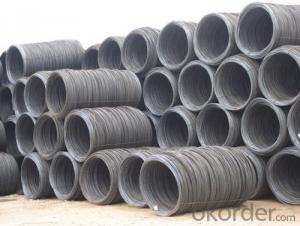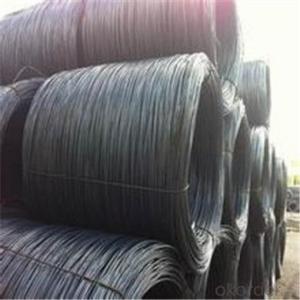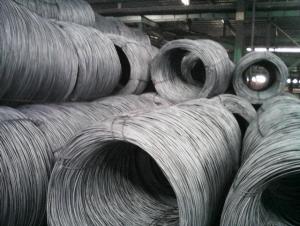GB Standard Steel Wire Rod with High Quality 7mm-8mm
- Loading Port:
- China Main Port
- Payment Terms:
- TT or LC
- Min Order Qty:
- 40 m.t
- Supply Capability:
- 15000 m.t/month
OKorder Service Pledge
OKorder Financial Service
You Might Also Like
Product Description:
Specifications of GB Standard Steel Wire Rod with High Quality 7mm-8mm:
Steel Grade: Q195 Standard: GB
Diameter: 7mm, 8mm
6.5mm can be drawing into 2mm/8.0mm can be drawing into 3mm
Each coil weight about 2MT
Chemical Composition:
Please kindly find our chemistry of our material based on Q195 as below for your information
Trademark | Rank | Chemical composition (quality score) % | |||||
C | Si | Mn | S | P | |||
| ≤ |
| ≤ | ≤ | |||
Q195 |
| 0.06-0.12 | 0.30 | 0.25 | 0.050 | 0.045 | |
Trademark | Rank | Pulling Test | |||||
Bend PointΔs/Mpa | Tensile Strength | Elongation Ratioδ5% | |||||
Thickness (Diameter) /MM | Thickness (Diameter) /MM | ||||||
≤16 | 16-40 | ≤16 | 16-40 | ||||
≥ | ≥ | ||||||
Q195 |
| 195 | 185 | 315-390 | 33 | 32 | |
Usage and Applications of GB Standard Steel Wire Rod with High Quality 7mm-8mm:
After hot-rolled the products shaped into coil and delivery as finished product, including round, square, rectangular, hexagonal and so on. Since most of the products are round, it is generally called wire rod. Carbon steel wire rod is widely used in construction and manufacturing. Carbon steel wire rod is mainly used for reinforcement of reinforced concrete and welded structure or reprocessed (roberts , nail, etc.) materials, especially used to produce wire drawing, welding electrode, nails, spring, electronic, precise machinery parts and so on.
Production Process of GB Standard Steel Wire Rod with High Quality 7mm-8mm:
Steel billet---Heating---Rolling---Water-cooling---Coiling---Cooling---Inspection---Bundling---Exworks
Packaging & Delivery of GB Standard Steel Wire Rod with High Quality 7mm-8mm:
Packaging Detail: products are packed in coil and then shipped by container or bulk vessel
Each coil weight: About 2MT
Delivery Detail: within 45 days after received deposit or LC.
Label: to be specified by customer, generally, each bundle has 1-2 labels
Trade terms: FOB, CFR, CIF
FAQ:
Q1: How soon can we receive the product after purchasement?
A1: Within three days of placing an order, we will begin production. The specific shipping date is dependent upon international and government factors, but is typically one month.
Q2: How do you guarantee the quality of our products?
A2: We have established an advanced quality management system which conducts strict quality tests at every step, from raw materials to the final product. At the same time, we provide extensive follow-up service assurances as required.
Q3: The prices are invoicing on theoritical weight or on actual weight?
A3: We can do it in both manners, according to the customers' request.
Images of GB Standard Steel Wire Rod with High Quality 7mm-8mm:


*If you would like to get our price, please kindly inform us the size, standard/material and quantity. Thank you very much for your attention.
- Q: What are the common defects that can occur during the processing of steel wire rod?
- Some common defects that can occur during the processing of steel wire rod are surface cracks, internal voids or inclusions, uneven dimensions, and incorrect chemical composition.
- Q: What are the main factors influencing the choice of steel wire rod payment terms?
- The main factors influencing the choice of steel wire rod payment terms include the volume of the purchase, the financial stability of the buyer and seller, market conditions, and the level of trust between the parties involved. Additionally, factors such as the duration of the business relationship, the buyer's creditworthiness, and the seller's cash flow requirements may also play a role in determining the payment terms.
- Q: What are the main factors affecting the customer satisfaction with steel wire rod?
- The main factors affecting customer satisfaction with steel wire rod include product quality, consistency, durability, price, timely delivery, customer service, and overall value for money.
- Q: What are the main properties of steel wire rod?
- The main properties of steel wire rod include high tensile strength, excellent ductility, and good resistance to corrosion. It also has a high elasticity, making it suitable for various industrial applications. Additionally, steel wire rod is known for its flexibility, durability, and ability to be easily formed into different shapes and sizes.
- Q: How is steel wire rod used in the production of nails?
- Steel wire rod is used in the production of nails as it serves as the primary raw material for manufacturing them. The wire rod is first drawn through a series of dies to reduce its diameter and achieve the desired thickness for the nails. It is then cut into appropriate lengths and shaped into the desired nail forms. The steel wire rod provides the necessary strength and durability required for nails, making it an essential component in their production process.
- Q: How is steel wire rod used in the manufacturing of wire for cable harnesses?
- Steel wire rod is a fundamental component in the manufacturing of wire for cable harnesses. The wire rod is initially heated and passed through a series of rolling mills to decrease its diameter and increase its length. This process is called wire drawing. Once the desired wire diameter is achieved, the steel wire rod is coated with a layer of insulation material. This insulation layer acts as a protective barrier, preventing the wire from coming into contact with other wires or conducting materials, thus ensuring safety and preventing electrical short circuits. After the insulation process, the coated wire rod is then further processed to create the specific wire shapes required for cable harnesses. This can include twisting, braiding, or stranding the wire to create cables with different properties and functionalities. The wire rod is also often cut into various lengths to accommodate the specific needs of different cable harness applications. The resulting wire is then used in the assembly of cable harnesses, which are used to organize and secure multiple cables or wires together within a system or device. These cable harnesses are commonly found in various industries, including automotive, aerospace, telecommunications, and electronics. Overall, steel wire rod plays a crucial role in the manufacturing of wire for cable harnesses. It provides the base material for wire drawing, allows for the application of insulation, and is further processed to create the necessary wire shapes. Without steel wire rod, the production of cable harnesses would not be possible, and the efficient organization and safe functioning of electrical systems would be significantly compromised.
- Q: What are the common methods used to protect steel wire rod from corrosion?
- There are several common methods used to protect steel wire rods from corrosion. These include the application of protective coatings such as paint or galvanization, which creates a barrier between the steel and the corrosive elements. Another method is the use of corrosion inhibitors, which are chemicals that can be applied to the surface of the steel to prevent rust formation. Additionally, proper storage and handling practices, such as keeping the wire rods in a dry environment and avoiding exposure to moisture or corrosive substances, can also help protect against corrosion.
- Q: How is steel wire rod used in the manufacturing of wire harness assemblies?
- Steel wire rod is an essential component in the manufacturing process of wire harness assemblies. Wire harness assemblies are intricate systems of wires, cables, and connectors that are used to transmit electrical signals and power in various industries such as automotive, aerospace, and telecommunications. Steel wire rod is typically used as the raw material for manufacturing the wire harnesses. It is first processed and drawn into thin, flexible wires of different gauges and diameters. These wires are then further insulated or coated with materials such as PVC, nylon, or Teflon to provide electrical insulation and protection against abrasion, heat, and moisture. The steel wire rod used in wire harness assemblies offers several advantages. Firstly, steel is a strong and durable material, providing the necessary strength and structural integrity to the wires. This ensures that the wire harness assembly can withstand the rigors of its intended application and environment. Additionally, steel wire rod has excellent electrical conductivity properties, allowing for efficient transmission of electrical signals and power through the wires. This is crucial in applications where high-quality signal transmission is required, such as in automotive electrical systems or telecommunications infrastructure. Moreover, the flexibility of steel wire rod allows for easy bending and shaping during the manufacturing process. This is important for creating complex wire harness assemblies that can fit into tight spaces or follow specific routes within a device or equipment. Overall, steel wire rod plays a vital role in the manufacturing of wire harness assemblies by providing strength, electrical conductivity, and flexibility. Its use ensures the reliability and performance of wire harnesses in various industries, contributing to the seamless functioning of electrical systems.
- Q: How is steel wire rod recycled?
- Steel wire rod is typically recycled through a process called electric arc furnace (EAF) steelmaking. In this process, the steel wire rod is melted down in an electric arc furnace, where impurities are removed. Once purified, the molten steel is cast into new wire rod shapes or other steel products. This recycling method helps conserve natural resources, reduces waste, and promotes sustainability in the steel industry.
- Q: How is steel wire rod used in the manufacturing of wire for power generation systems?
- Wire rod made of steel is a crucial raw material utilized in the production of wire for power generation systems. It acts as the main material for manufacturing top-quality cables used for transmitting and distributing electricity from power plants to various destinations. The manufacturing process commences by carefully selecting steel wire rod based on its specific properties, such as strength, durability, and conductivity. The rod is then heated to the suitable temperature and passed through a series of dies to shape it into the desired wire diameter. This process, known as wire drawing, involves reducing the rod's diameter while increasing its length. After the wire has been drawn to the required size, it undergoes various treatments to enhance its mechanical properties. These treatments may include annealing, where the wire is heated and gradually cooled to relieve internal stresses and improve its flexibility and ductility. Additionally, the wire may be galvanized, which involves applying a protective layer of zinc to prevent corrosion and prolong its lifespan. The manufactured wire is then utilized in the construction of power transmission and distribution cables. These cables play a crucial role in efficiently and safely delivering electricity over long distances. The steel wire provides the necessary strength and tensile properties to support the cables' weight and withstand the mechanical stresses during installation and operation. It also ensures that the cables maintain their shape and structure even when subjected to external forces like wind, ice, and temperature changes. Furthermore, the electrical conductivity of the steel wire allows for efficient transmission of electricity, reducing power losses during transmission. This property is particularly important in power generation systems, where minimizing energy losses is vital for the effective and economical delivery of electricity. In conclusion, steel wire rod is an indispensable component in the production of wire for power generation systems. It possesses the required mechanical strength, durability, and electrical conductivity needed for power transmission and distribution cables. By enabling efficient and reliable electricity transmission, steel wire plays a crucial role in powering our homes, businesses, and industries.
Send your message to us
GB Standard Steel Wire Rod with High Quality 7mm-8mm
- Loading Port:
- China Main Port
- Payment Terms:
- TT or LC
- Min Order Qty:
- 40 m.t
- Supply Capability:
- 15000 m.t/month
OKorder Service Pledge
OKorder Financial Service
Similar products
Hot products
Hot Searches
Related keywords



























